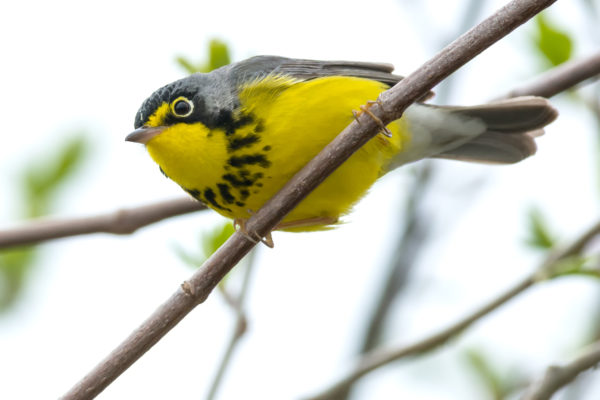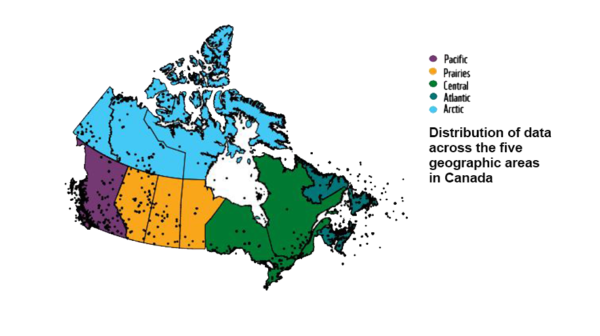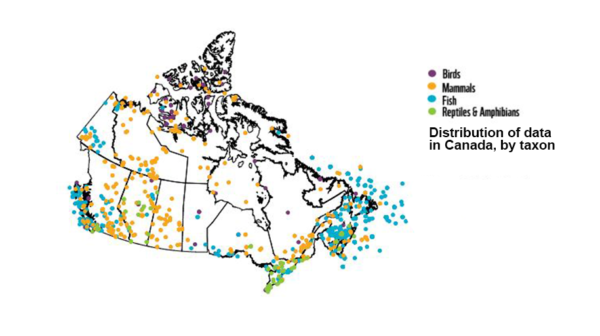The science we have – and the science we need to stop wildlife loss
Living Planet Report Canada – among the most comprehensive studies of monitored vertebrate wildlife population trends ever conducted in Canada – has revealed a depth and breadth of loss that’s unexpected in a country that takes such pride in its image as a land of wild places. From a scientific perspective, our work is just beginning. What’s next?
The data we have
The foundation of this study is the Living Planet Index (LPI), a peer-reviewed indicator of aggregated trends in wildlife populations across groups of vertebrate species, as developed by the Zoological Society of London (ZSL). Over the past 18 months, our team of scientists and analysts at WWF-Canada has gathered monitoring data and scientific studies on mammals, birds, amphibians and reptiles, and fish across the country.
Building on data available from the publicly available Living Planet Index Data Portal, we compiled an updated national dataset for Canada comprised of 3,689 population records for 903 species. This dataset also includes new records compiled by the Zoological Society of London, as well as the Canadian Environmental Sustainability Indicators group of Environment and Climate Change Canada.
We then added data for 418 species, more than 2,000 populations, and 86 data sources. That data is derived from peer-reviewed scientific literature, government monitoring (e.g. Fisheries and Oceans Canada trawl surveys) and citizen science (e.g. North American Breeding Bird Survey). Criteria for data inclusion in the study followed the approach established by ZSL, and an additional criterion for native species was added for our national-level analysis. The analysis of the Living Planet Index was adapted from the Zoological Society of London’s publicly available R-Statistical package on GitHub. (Full details on modifications to the analysis to suite a national-scale undertaking for Canada are described in our technical appendix.)
Through the LPI, we conducted a systematic analysis of broad patterns of Canada’s wildlife by major species groups (taxons) and across five geographic regions.
While the findings of our study showed steep declines in mammals, marine fish in Atlantic Canada, amphibians and reptiles, and certain kinds of birds (especially grassland birds and shorebirds), the report also revealed a significant lack of data in a number of areas. Particularly concerning: the lack of data for a key realm – freshwater; and a key environment – Arctic.
The data we need
Considering the interconnectedness of terrestrial, freshwater and marine ecosystem (as illustrated by the critical importance of Chinook salmon as the primary prey species for southern resident killer whales off the coast of British Columbia), it’s essential that we have robust data on all three realms, as well as all major taxonomic groups, right across the country.
Filling the gaps – get involved
Canadians from coast to coast to coast can help overcome this data deficit by becoming citizen scientists, collecting information on both wildlife and their habitats. That information should be a critical element of a systematically designed national monitoring system, which could be created by communities, research institutions, environmental groups and governments. That data could be used to inform decisions on where needs are greatest – what species are in most urgent need of attention, what habitat most urgently needs protection or restoration, and which actions will, measurably, be most effective at stopping decline fastest.
Embrace new technologies
The quality and quantity of that data could be vastly improved and increased if we embrace new technologies like environmental DNA testing that will dramatically enhance the value of citizen scientist-efforts by resulting in faster delivery of robust findings, upon which decisions about appropriate conservation actions and habitat management can be made.
Climate change – a complicating factor
Armed with top quality, comparable data, we’ll be in a significantly better position to target conservation actions for maximum effectiveness. This is even more important when you factor in the increasing and accelerating impacts of climate change. We know that weather patterns are changing, triggering life-cycle events like mating, migration and spawning at the wrong time – or not at all. We know that wildfires, droughts, floods and rain/freeze events are already having a direct impact on wildlife. And we know that wildlife are on the move as their range expands or as existing habitat becomes inhabitable. Native species now face the threat of invasive species and climate-change-driven migratory species.
Enhanced research on the impacts of, and responses to, climate change are essential to understanding how wildlife, and their habitats, already are and will be affected – so we aren’t making decisions on habitat protection and species recovery in a vacuum. Ranges are already shifting, prey species are moving, and even new predator and prey situations are presenting (as is the case with narwhal and orcas in the Arctic). What’s more, on a very basic level, we simply don’t know how the buildup of atmospheric carbon will further contribute to species decline. When you consider that the two ecosystems that are the least well-studied – freshwater and Arctic – are the two areas climate change expected to hit hardest, the need for data becomes all too evident.
Be part of the solution
Gathering knowledge is the most important first step in solving any complex problem. Considering most of the stressors wildlife face (habitat loss and fragmentation, pollution, climate change and more) are human-caused, we all want to be part of the solution. Across Canada, individuals can make a difference by joining the growing citizen science movement to help community groups, research institutions and governments gather the information – particularly in underrepresented geographic areas or for underrepresented species groups – necessary to take even more decisive and effective actions.




